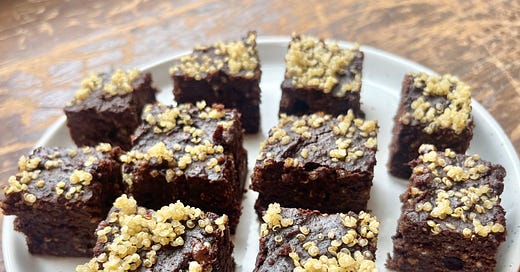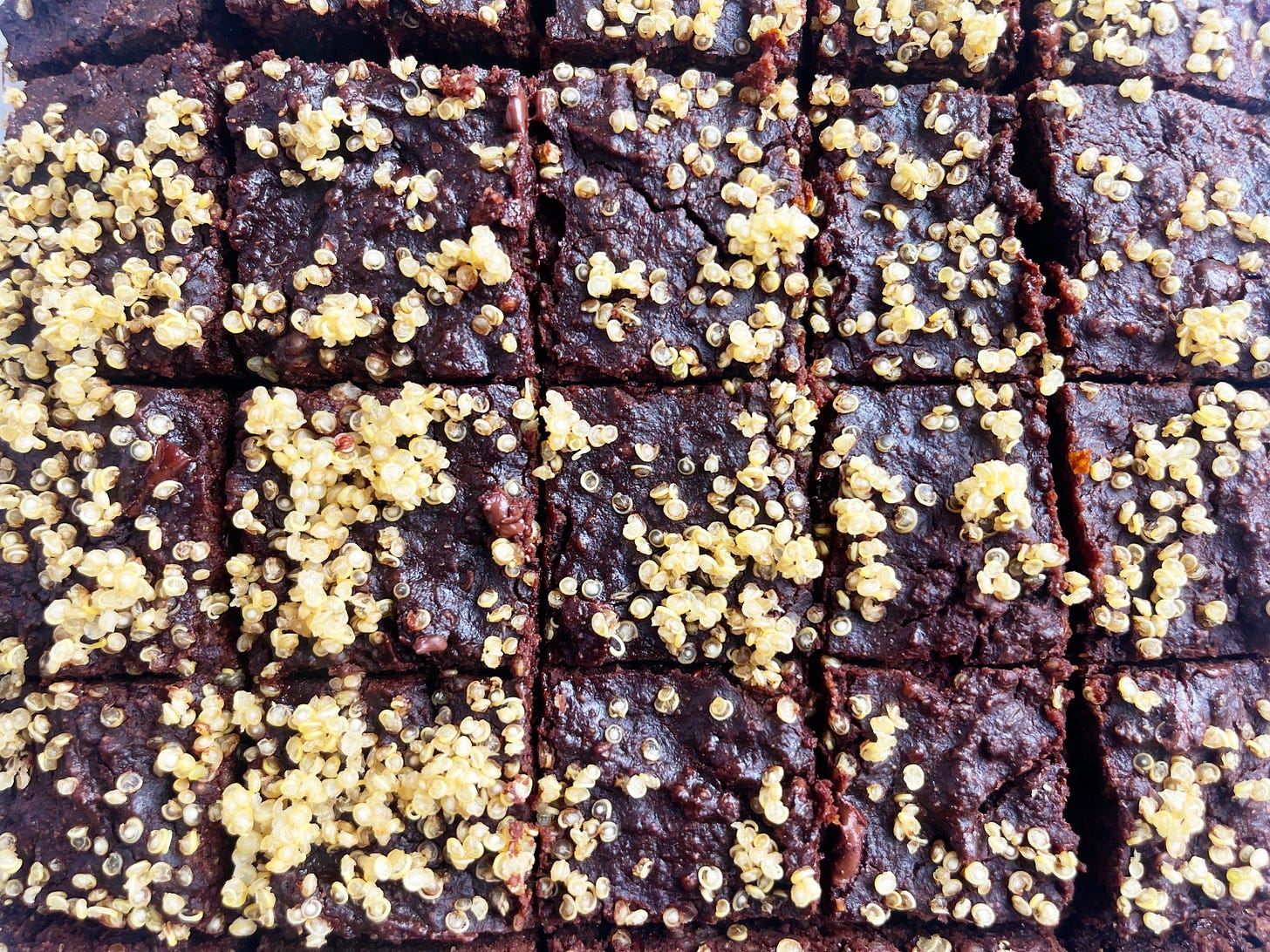You may not think you need another brownie recipe, but you do! You need this new recipe for Fudgy Quinoa Brownies. Adding cooked quinoa to brownies is not just a brain health move—the grain adds a pleasantly chewy texture and a nutty, earthiness to the dark chocolate flavor. Scattering more quinoa atop creates a crinkly crust. The tiny seeds pack in a lot of brain health nutrition, too: fiber, flavonoids, omega-3 fats, and protein, including all nine essential amino acids.
There’s a chance that quinoa flour may be new to you. It’s a fantastic whole grain flour to have in your pantry. I fell in love with its nutty aroma when testing recipes for my book. It turned out to be the perfect, protein-packed flour to make my Caramelized Apple and Quinoa Pancakes (page 274) a hearty breakfast. Open a bag and see for yourself—quinoa flour smells just like freshly steamed quinoa. If you can’t find it (see Tips), other flours—like almond flour—work well here.
These brownies are doubly chocolatey, thanks to a combination of natural cacao powder and dark chocolate chips. When I did a deep dive into heavy metals in chocolate products, I was happy to learn that a common, not-fancy brand of natural cacao powder from Hershey’s ranked lowest in lead and cadmium contamination. That got me wondering: which cocoa powder provides the most flavanols?
Flavanols are the key to chocolate’s health-promoting properties
The healthy elements of chocolate mostly come from its flavanol content, which varies wildly from brand to brand. In general, 100 grams (about 1 cup) of unsweetened cocoa powder has about 250 mg of flavanols, but it can be as low as 50 mg or as high as 900 mg. One reason I always call for natural cocoa powder in my recipes is that it has more flavanols than Dutch process cocoa. (Dutching changes the pH of chocolate ro remove bitter flavors, but the process removes most of the flavanols, too.)
So not only was I curious to find the most potent natural cacao powder for my brownies, I also wanted to learn: how much chocolate does one need to eat daily to provide enough flavanols to boost memory and thinking skills?
A brief history of cocoa flavanol studies
There are more than a dozen clinical trials looking at the impact of cocoa flavanols to improve both heart and brain health. Here are a few of the highlights:
In the Cocoa, Cognition, and Aging study (also called CoCoA) published in 2014, researchers compared cognitive and health biomarkers of participants who consumed different doses of a daily chocolate drink at three doses of flavanol: low (48 mg), intermediate (520 mg), and high (993 mg) flavanol content. Good news: higher doses of flavanol were associated with better performance on some aspects of cognitive function (verbal fluency and the trail drawing test). And, as flavanol dose went up, so did improvements in biomarkers for insulin resistance, such as lower blood pressure, fasting glucose, and insulin levels. The downside: participants were only followed for 8 weeks, not long enough to account for a placebo effect.
A much larger, longer-duration study, COSMOS (the Cocoa Supplement and Multivitamin Outcomes Study) was published in 2022. It looked at cacao’s ability to reduce heart attack and cardiovascular death in over 21,000 healthy adults studied for 3 years. Participants were randomly assigned a cocoa extract supplement (providing 500 mg flavanols), a multivitamin, or a placebo, then followed to measure the incidence of cardiovascular events (like heart attack, stroke, and angina), and cardiovascular deaths. Good news: the cocoa supplemented group didn’t have any fewer events, but they were 27% less likely to die from such an event. This gets to the root of what much of the science of chocolate has shown: flavanols help keep the endothelium (the lining of blood vessels) elastic and smooth. This endothelium is a key factor in both heart and brain health. The downside: taking a daily multivitamin did not impact cardiovascular outcomes.
COSMOS-MIND, a subset of COSMOS, evaluated the cognitive function of over 2200 dementia-free older adults who took cocoa flavanols vs. a multivitamin vs. a placebo over three years. Good news: The multivitamin group showed improved global cognition, episodic memory, and executive function after 3 years. Put another way: 3 years of multivitamin supplementation appeared to have slowed aging by 1.8 years, or by 60%. The downside: researchers found no difference in cognition from taking 500 mg cocoa flavanols compared to placebo.
Cocoa flavanols exert a positive brain health impact mostly indirectly, by fostering blood vessel health. However, the dose for proving a reduction in heart disease risk (around 500 mg) is lower than that needed to have a significant impact on memory. In all the studies I reviewed, you would need to consume a high daily dose of cocoa flavanols—around 600 to 900 mg— to show improvements in thinking and memory skills. These results were seen in the short term studies (a few months duration) but didn’t pan out in the longer COSMOS trial. In simple terms, this means you’d have to have at least 2 high-flavanol chocolate bars (such as Chocolove 70% Strong Dark) a day to see those benefits.
What about cocoa flavanol supplements?
CocoVia is a cocoa extract supplement providing 500 mg daily dose. The products’ marketing draws heavily from the short-term CoCoA study, quoting improvements in memory of 20%, but doesn’t mention the three-year data from COSMOS showing no benefit in overall cognitive function. The real winner in the COSMOS study was a simple multivitamin, not an expensive dose of cocoa extract.
How much flavanol is in your chocolate?
You won’t find the flavanol content listed on nutrition labels. It takes some digging to determine how much a product contains, if it’s even measured. (I use ConsumerLab.com, an independent lab that evaluates food products.)
In general:
Natural cocoa powders provide more flavanols than Dutch process cocoa.
Dark chocolate provides more flavanols than milk chocolate.
Cocoa powder is a more potent source than bar chocolate: one tablespoon of natural cocoa powder has about the same flavanol content of a whole bar of dark chocolate.
Cocoa nibs generally provide more flavanols than chocolate chips
Cocoa flavanol supplements are a reliable, yet expensive, source of flavanols.
My Hershey’s natural cocoa powder, I discovered, is low on the flavanol scale: about 190 mg cocoa flavanols per 1 cup cocoa powder. Navitas Organics cacao powder, my second favorite cocoa powder (a more expensive choice), has significantly more: 2500 mg cocoa flavanols per 1 cup cocoa powder. It tests below the allowable threshold for lead contamination, but just missed the cadmium cut-off. In a recent review, Consumer Labs found only one brand of cocoa powder that is high in flavanols yet low in lead and cadmium: Good and Gather Unsweetened Cocoa Powder (distributed by Target).
Still, you’d have to eat about a half a pan of my Fudgy Quinoa Brownies made with Navitas cocoa powder every day to get the dose of flavanols shown to be cardioprotective. They are really good, but I’m not recommending this! It’s far better to get all the flavonoid compounds (flavanols, flavones, flavan-3-ols, isoflavones, anthocyanins) from a variety of sources in your diet: apples, pears, green tea, whole soy foods, leafy greens, onions, citrus fruits, berries, and many more. The data here is solid: eating a diet full of flavonoid-rich foods improves thinking and memory skills now, while reducing Alzheimer’s risk by as much as 50% in the decades to come.
The bottom line for brain health: You have to eat a lot of chocolate to get medicinal doses of flavanols
Chocolate—as much as we may love it—is not a reliable source of flavanols. But chocolate can absolutely be part of a brain-healthy dietary pattern. Flavanols are so key to brain health that it’s not advisable to rely on one type of food to get them.
Please do enjoy these quinoa brownies, which give you a nice dose of flavanols, but also eat a wide variety of flavanol-rich foods each day. A good cup of green tea, especially, can approach the same level of flavanols you’d get from an entire bar of dark chocolate. What’s a good cup of green tea? That’s a topic for a future newlsetter.
What’s your favorite way to get a good dose of cocoa flavanols?
RECIPE: FUDGY QUINOA BROWNIES
Makes 16 2-inch brownies
Ingredients:
⅓ cup dry quinoa (or 1 cup leftover cooked quinoa)
½ teaspoon kosher salt, plus more for cooking the quinoa
2 large eggs
½ cup maple syrup
¼ cup extra-virgin olive oil
1 teaspoon pure vanilla extract
Zest of one orange, ½ teaspoon orange blossom water, or ½ teaspoon orange extract (optional)
2 tablespoons water
¾ cup quinoa or almond flour
½ cup natural cocoa powder (not Dutch processed)
½ cup dark chocolate chips (I like Guittard extra dark chocolate chips, which are both high in flavanols and low in heavy metals)
Directions:
Preheat the oven to 400ºF. Line an 8-x-8-inch baking pan with parchment paper; set aside.
To cook the quinoa, bring a small saucepan of salted water to a boil. Add the quinoa, reduce the heat to a simmer, and cook until plump and the grains sprout a tail, about 12 minutes. Drain and set aside to cool.
Whisk together the eggs, maple syrup, oil, vanilla, orange zest (if using), and 2 tablespoons water in a medium bowl until smooth.
Fold in the quinoa flour, cacao powder, and ½ teaspoon salt until no streaks of flour remain. Set aside 3 tablespoons of the cooked quinoa to top the brownies, then fold the rest into the batter, along with the chocolate chips, stirring until evenly distributed.
Scrape into the prepared pan and smooth over the top with a spoon. Sprinkle the remaining quinoa overtop.
Bake until the center is set and a toothpick placed in the center comes out clean, 22 to 26 minutes.
Cool brownies in the pan for at least 30 minutes. Lift parchment paper and place brownies on a cutting board. Cut into 16 squares.
Tips:
When cooking quinoa, make extra. It keeps well in the fridge or freezer, ready for impromptu brownie baking and much more.
White quinoa works best in this recipe. When made with red or black quinoa, the grains did not add the same chewy texture to the brownies.
Find quinoa flour in the gluten-free baking section of the grocery store, online, and at Bob’s Red Mill. Here’s a DIY version: toast 1 cup raw white quinoa in a large skillet over medium-low heat until it is a shade darker, and smells like popcorn, about 10 minutes. Be careful to toss well so it doesn’t burn. Pour into a powerful blender and pulse until pulverized to the consistency of fine flour, about 2 minutes. Strain through a fine mesh sieve to remove any larger pieces. Store in an airtight container.
Other flours work well here: almond, hazelnut, white whole wheat, spelt, and whole wheat. I’ve tried them all in my quest to get these brownies just right.
I really like these brownies with orange zest or extract, but they are just as good without if that’s not your thing.
As always, thank you for reading, sharing, and for taking good care of your brains. I’ll be writing to you Friday on my way to the Panama Brain Health Retreat with a round-up of my favorite travel snacks. Until then, enjoy your week.
Love,
Annie







Wondering in addition to all the dietary guidelines and recommendations if you recommend additional supplementation and if so which ones and which specific brands?
Thanks
I don't understand what you do with the quinoa. Can I just put it in my blender to turn it into flour? Do I need to cook it? Or do I use 1 cup of cooked quinoa instead of flour?